Organizations of all sizes require an established, organized structure to drive business outcomes. However, not all companies function best with a traditional, hierarchical organizational structure.
A lack of organizational structure (or choosing the wrong type of structure) leads to miscommunication, work delays, poor process flows, tepid employees, and other serious consequences that stunt business growth. In contrast, a robust organizational structure enables employees to coordinate teamwork, understand their tasks and responsibilities, reduce conflicts, and boost productivity.
How do you design an organizational structure that’s right for your company?
What are common types of organizational structures?
What Is Organizational Structure?
Organizational structure is the backbone of all operating procedures and workflows at any company. It determines each employee’s place and role in the business and is key to organizational development.
A clear structure allows every team member to be involved. When employees know what they’re responsible for and who they report to – which isn’t the case in many fast-growing companies – they’re more likely to take ownership of their work.
Having a documented organizational structure in place enables employes to improve efficiency and provides clarity for each individual employee and business unit. With this clarity, departments can become more focused on how their actions and goals drive business outcomes.
To build an org structure, you need to consider your business size, life cycle, goals, and positioning. Apart from considering the current environment your company operates in, you should also think of where you want to see the organization in five years, a sign of organizational health.
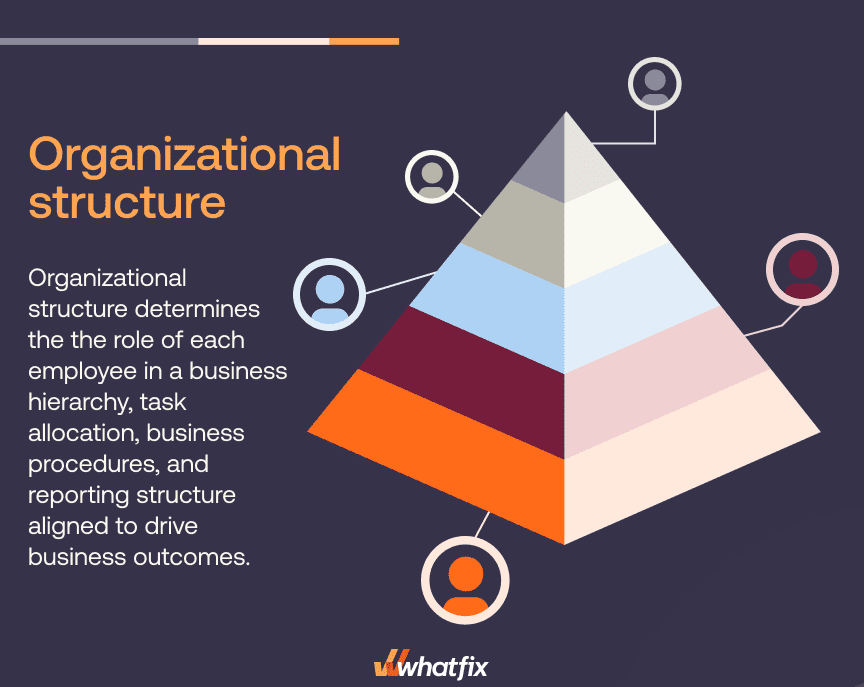
Related Resources:
Basic Elements of Organizational Structure Design
An organizational structure is based on a range of elements, including:
- Work specialization
- Departmentation
- Chain of command
- Span of control
- Centralization/Decentralization
- Formalization
Work specialization
Work specializations define how responsibilities are split between employees based on the job description. It’s used to split projects into smaller work activities and assign digestible tasks to individual employees. The most common results of improper specialization are low efficiency and burnout.
Documentation
Documentation is an act of grouping specialists on the basis of the job description, skills, location, or other factors that connect them.
The biggest challenge is choosing the criteria for departmentation. In many cases, it’s no more enough to apply functional departmentation – where employees are grouped based on the tasks they perform. Startups often go for matrix departmentation that involves combining two types of departmentation and takes the best out of both worlds. For instance, functional departmentation can be joined by geographical departmentation to better serve clients in different locations.
Chain of command
Chain of command represents a system for passing instructions and reporting within an organization. Ideally, it distributes the power, supports knowledge sharing, and encourages employee accountability.
The traditional chain of command makes decision-making more complex and does not allow for much flexibility. On the contrary, modern approaches strive to enhance employee autonomy and avoid micromanagement.
Span of control
Span of control regulates the number of direct reporters managed by a single supervisor. It heavily depends on the three aforementioned elements of organizational structure. Furthermore, to identify the right span of control, you need to evaluate your leaders’ capacity, workplace size, and experience level of employees.
Centralization and decentralization
Centralization and decentralization are the concepts defining how managers, as well as employees, give input on company goals and strategy. While centralization gives leaders the ultimate control over decision-making processes, decentralization allows employees to impact business decisions.
Formalization
Formalization determines to which extent business processes, policies, and job descriptions are standardized. It may regulate communication between employees and managers, workplace culture, operational procedures, etc.
Centralized vs. Decentralized Organizational Structures
All organizational structures are either centralized or decentralized. When designing an organizational structure, leaders must decide which is best for your company. Here are the differences between the two:
Centralized organizational structure
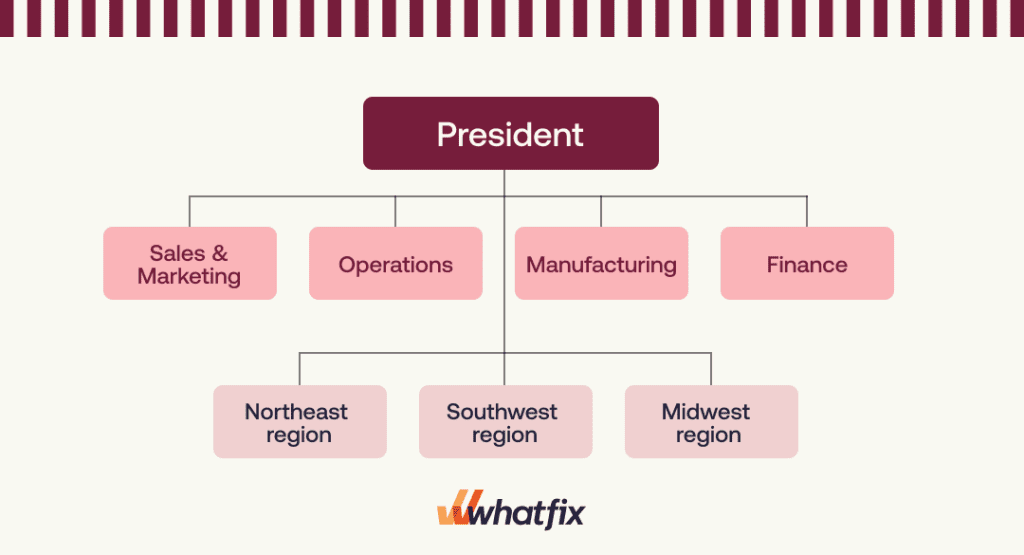
In a centralized organizational structure, decisions are made by high-level managers and are distributed down the chain of command.
Centralized organizational structures have a range of advantages, like clear responsibilities, better process governance, and a straightforward chain of command. It places decision-making responsibilities on leadership who can foresee the long-term impact of important decisions.
The biggest drawback of a centralized organizational structure is the time the decision-making process takes in large companies. For example, individual team managers must run requests up the chain of command before going forward.
For GTM and customer-facing teams, this can slow down the customer experience, resulting in missed opportunities and poor service. It can also hamper companies’ ability to innovate, with centralized organizations being less agile and nimble than decentralized ones.
Often, it’s recommended that early-stage startups and small businesses design a centralized organizational structure.
Decentralized organizational structure
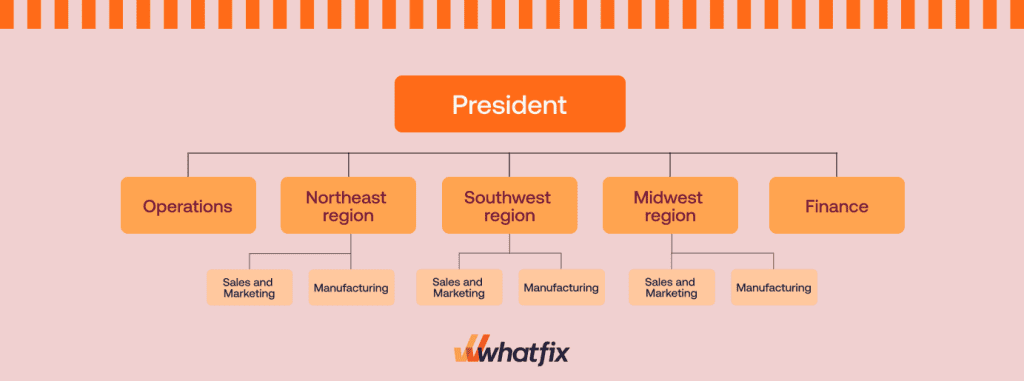
In a decentralized structure, lower-level employees identify issues and make decisions without communicating them up the chain of command to upper management. Greater autonomy empowers employees to take action, eliminating process delays, enabling employees with confidence to make decisions, and driving growth.
Even in decentralized organizations, clear hierarchies still exist. The c-suite, directors, and other leadership roles still operate at a higher capabilities than new and entry-level employees. However, teams can make decisions without approval from centralized leadership, allowing them to act fast and take ownership of their areas of expertise.
This type of structure is common for fast-growing companies, companies with regional markets, and emerging industries. A decentralized structure makes it more accessible for employees to navigate different roles and work on what’s most impactful at that time in a company’s lifecycle.
How do they compare? Quick differences:
| Centralized Organization | Decentralized Organization | |
| Decisions | One high-level management body at the top of the command creates company strategies, builds procedures, assigns roles and acts as decision-makers. | Directors and management at different levels (whether that’s regional-based, department-based, subsidiary-based) makes decisions for their specific department and teams. |
| Communication | Information and decisions come from the top down. Employees down the org chart follow orders from c-suite and executives. | Inter-departmental communication happens openly and freely. Allows for different teams to experiment and share results with other business units. |
| Responsibilities | Overall company strategy (and success) comes from a small group of c-suite executives who design and execute this vision with little input or feedback from others. | Department leaders, managers, and employees are all responsible for the success of the company. Enables employees to innovate, share input, and provide feedback. |
| Company size | Best for smaller organizations. | Best for large organizations with sprawling business units. |
7 Types of Organizational Structures
The key purpose of any organizational structure is to make decision-making processes straightforward and provide clear definitions for roles and responsibilities. However, there are many ways to achieve that.
Let’s look at seven common types of enterprise organizational structures to help you decide what’s best for your company and its various departments and teams.
1. Functional structure

A functional structure groups employees into different departments by work specialization. Each department has a designated leader highly experienced in the job functions of each employee supervised by them.
Most often, it implements a top-down (centralized) decision-making process where department managers report to upper management. Ideally, leaders of different teams communicate regularly and coordinate their strategies while lower-level employees have little idea of the processes taking place outside their department.
The main challenge companies with a functional structure face is the lack of coordination between departments. Employees may lose the larger company context when focusing on specific tasks and failing to interact with members of other departments.
You’ll need to train leaders to foster collaboration across departments to create a functional organizational structure.
Best For: Companies that require a high degree of specialization and efficiency within each department, like manufacturing firms.
Pros of a functional organizational structure:
- Scalable.
- Operational efficiency.
- Encourages employees to specialize their skillsets.
- Empower employees to focus on their specific roles and responsibilities.
- Empowers teams and departments with clear, specific goals that they can work towards.
Cons of a functional org structure:
- Leads to poor cross-department communication.
- Builds silos.
- Creates obscure roles, processes, and workflows that are company or industry-specific.
2. Divisional structure
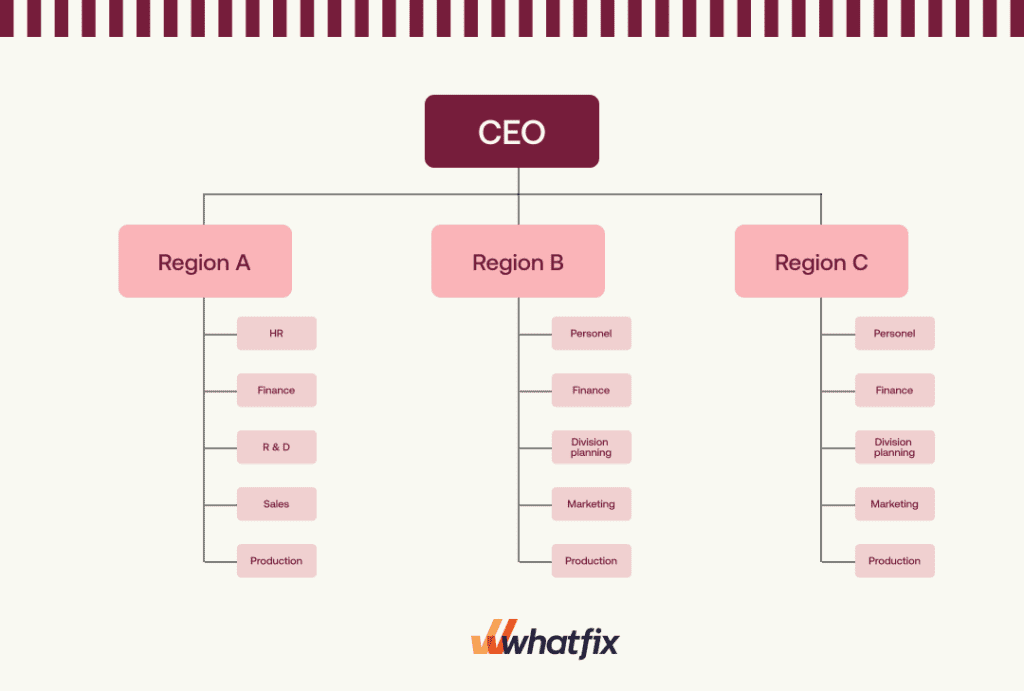
In a divisional organizational structure, the company is divided into different business units that have complete control of their budget, resources, and strategy – essentially acting as an independent company. Each division can have its own dedicated marketing, sales, product, and IT teams.
A divisional structure works well with large enterprises who have multi-product offerings, have acquired or merged with multiple business entities, service many geographical regions, and serve different industries.
Examples of companies applying a divisional structure are McDonald’s Corporation and Disney. These brands can’t help but split the entire organization by location to be able to adjust their strategies for audiences representing different markets.
These smaller groups are relatively independent and mainly follow a decentralized framework. Still, the leaders of each department are likely to operate under centralized corporate management. This means that the company culture is dictated by top management, but operational decisions can be made independently by each division.
Divisional organizational structures can be divided according to a few different factors, including:
- Market-based divisional org structure: Divisional organizational structures can be divided by market or customer type. For example, Walmart could separate its its internal business units by department and have separate entities that own children’s toys, clothing, electronics, food and beverage, etc.
- Industry-based divisional org structure: Business units can by divided by the industry or use case they target. Consider Salesforce. It packages it Sales Cloud product to verticals based on sector, like Education Cloud, Nonprofit Cloud, Health Cloud, etc.
- Product-based divisional org structure: Enterprise companies often have a multi-product offering and divide its organization up by product line. For example, Google has entire organizations that focus only on AdSense, YouTube, YouTube TV, Google Search, Google Maps, and so forth. Salesforce has entire division dedicated to Sales Cloud, Slack, Salesforce CPQ, etc.
- Territory-based divisional org structure: Business units are divided up by geographical regions, enabling companies to localize their efforts based on the needs, values, characteristics, and demographics of each area. This can be divided into regions (like north, west, south, midwest, etc.), a country’s states or provinces, by country, or by continent.
Best for: Large enterprises that operate in multiple markets, such as multinational companies or conglomerates, as it allows each division to focus on its specific market or product line.
Pros of a divisional organizational structure:
- Understand individual markets, sectors, and products better.
- Promotes flexibility.
- Faster responses to changes or needs that are locality or regional-based.
- Autonomous approaches lead to team experimentation and allow organizations to test multiple strategies, driving innovation.
Cons of a divisional structure:
- Can result in duplication efforts like multiple applications that do the same thing.
- Siloed teams and data with poor knowledge transfer.
- Poor documentation.
- Lack of organizational communication.
- Departments compete against one another.
- Lack of hierarchy understanding.
3. Matrix structure
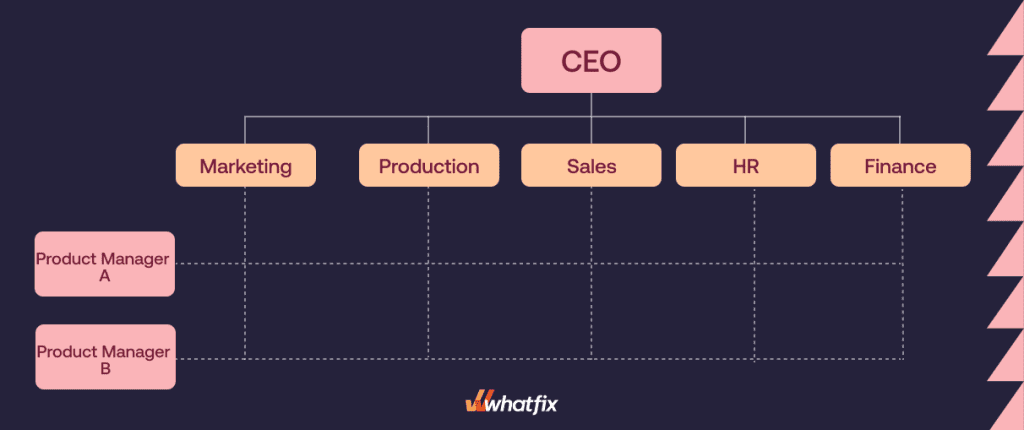
Within a matrix organizational structure, team members report to several managers at once. Wait, what’s the point?
Having multiple supervisors allows for company-wide interaction and faster project delivery. For instance, when answering to functional managers and project managers, employees have a chance to collect experience outside their team. While functional managers can help to solve job-specific issues, project managers can bring in knowledge or talents from other departments.
If you go after a matrix organizational structure, you’ll need to find a way to avoid authority confusion and prevent conflicts between managers.
Best For: Organizations that need to balance the benefits of functional and divisional structures, like project-based companies, consulting firms, or companies involved in complex projects requiring cross-functional collaboration.
Pros of a matrix organizational structure:
- Flexibility to pull employees into more important projects at will.
- Empower employees to build and test skillsets outside of their pre-determined roles.
- Faster project deliverables.
- Provides a more dynamic view of the organization.
Cons of a matrix structure:
- This often leads to conflicts among leaders and project managers.
- Confusion on authority.
- Frequency of change leads to fatigue and resistance.
4. Team-based structure
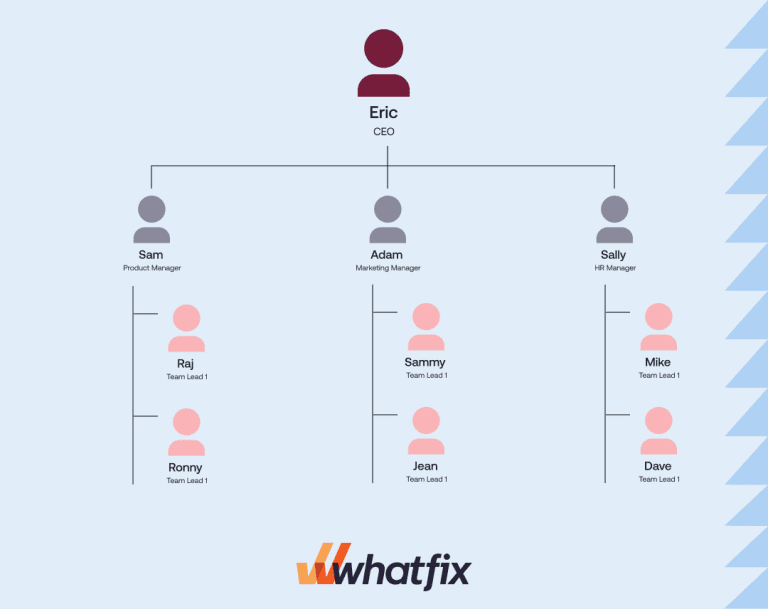
A team-based organizational structure creates small teams focusing on delivering one product or service – often via Scrum or tiger teams. These teams can solve problems and make decisions without bringing in third parties.
Team members are responsible for managing their workload and have full control over the project. Team-based organizations are distinguished by little formalization and high flexibility. This structure works well for global organizations and manufacturers.
Best For: Companies prioritizing flexibility, innovation, and quick response to market changes, like tech startups or creative agencies, where collaboration and teamwork are essential.
Pros of a team-based organizational structure:
- Drives growth and innovation.
- Promotes lateral career moves.
- Provides experiences across departments and teams.
- Experience is valued over seniority.
- Less emphasis on management.
- Encourages lateral moves.
- Is more agile and fits well with Scrum models.
Cons of a team-based structure:
- No clear authority.
- Career path growth is not clear.
- Not formalized.
5. Network structure
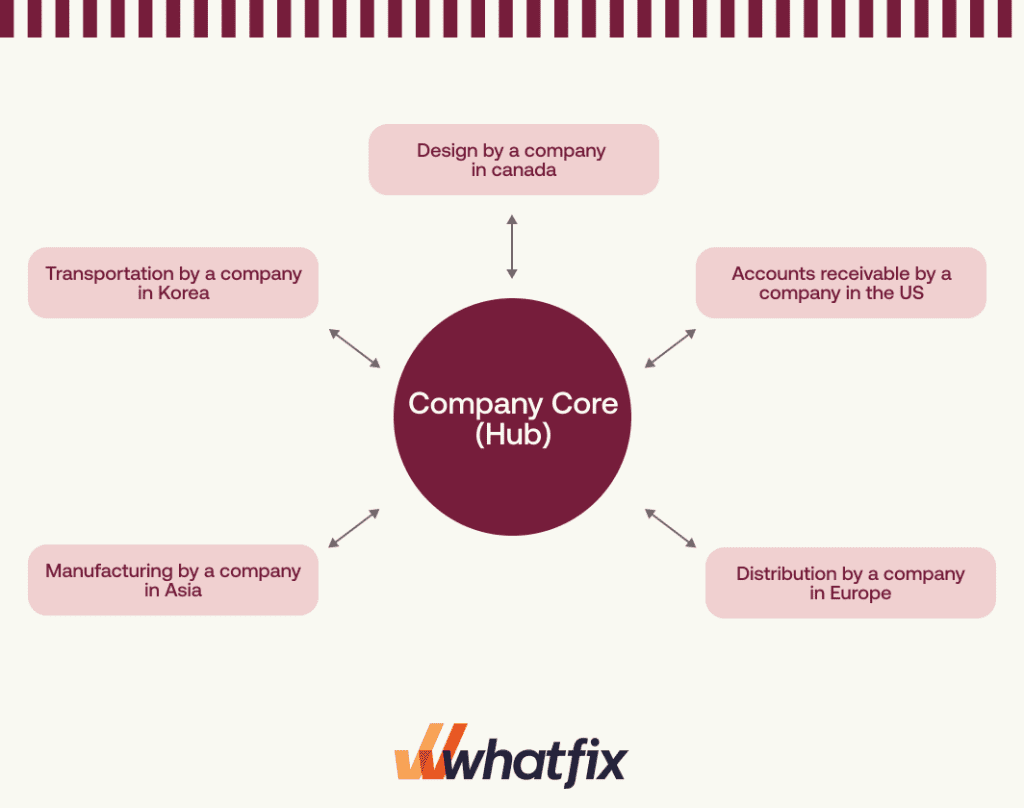
A network structure goes far beyond your internal company structure. It’s the act of joining the efforts of two or more organizations to deliver one product or service. Typically, a network organization outsources independent contractors or vendors to complete the work.
In a network organization, teams are built from full-time employees as well as freelance specialists – this way, in-house workers can spend most of their time focusing on the work they specialize in. Such an approach allows companies to adapt to market changes and obtain the skills they need quickly.
Working with individuals not integrated into your company culture results in lower formalization and higher agility.
Best For: Companies that outsource business functions and rely on external partners, like businesses with extensive supply chains and franchises, or companies that focus on core competencies while leveraging partnerships for other operations.
Pros of a network structure:
- Promotes organizational agility and flexibility.
- Fosters collaboration across employees.
- Breaks down silos.
- Cultivates better understanding of industry, products, and customers.
- Creates a web of work-related relationships.
- Creates highly specialized skills in employees.
Cons of a network structure:
- Extremely complex and convoluted.
- Lower formalization.
- High turnover.
- There is a feeling of inequality between full-time employees and contractors/freelancers.
- It’s difficult to know who has final approval.
6. Hierarchical structure
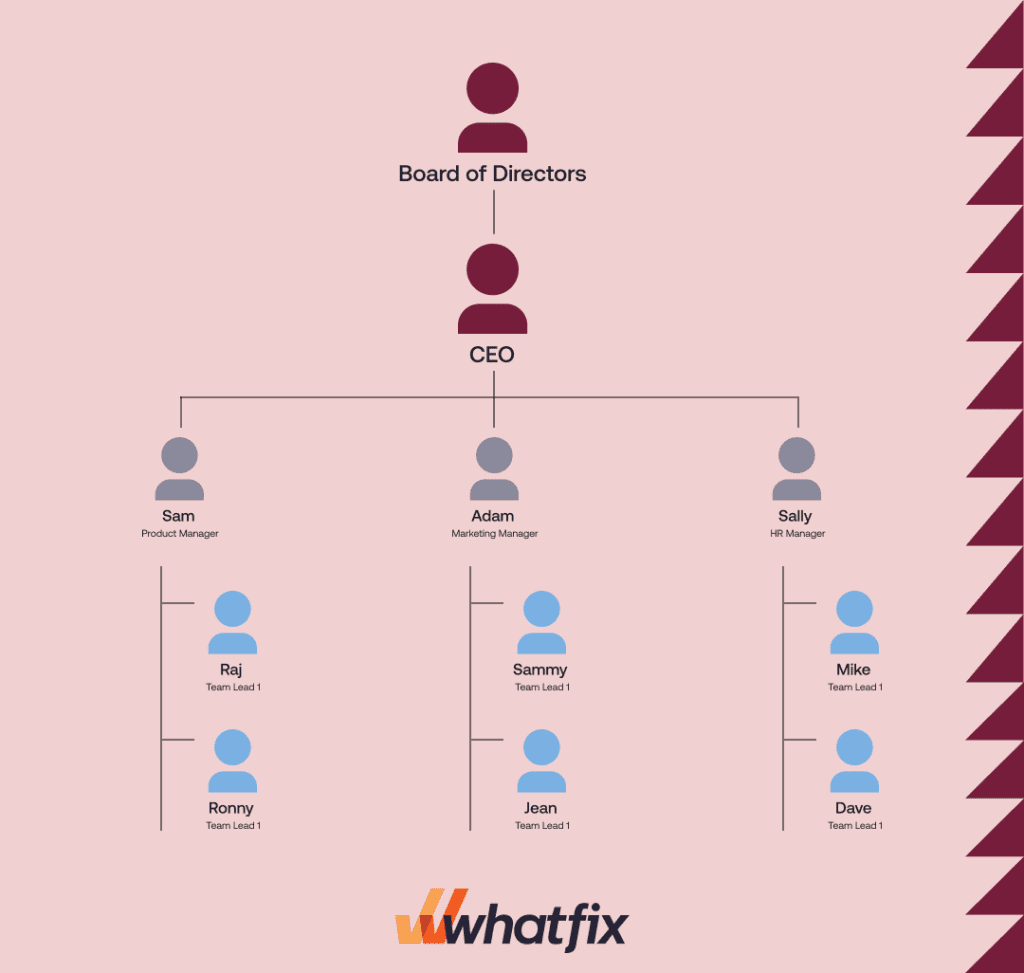
A hierarchical structure is the most common type of organizational structure. This pyramid-shaped structure follows a direct chain of command from the top (the CEO) and flows down the org chart through individual teams and entry-level employees.
The chain of command goes from the C-suite to senior management to team leaders to lower-level employees. The highest-level executive (typically the CEO) has the most power and authority on the decision-making process.
On one hand, this structure enables organizations to streamline business processes, develop clear career paths, and reduce conflicts. A company hierarchy leaves no place for challenging managers’ authority, which can sometimes be a good thing.
On the other hand, a hierarchical structure slows down decision-making and may hurt employee morale. Poor leadership – or even a bad CEO – can lead to the downfall of an organization with a hierarchal structure.
Best For: Traditional, stable organizations with clear authority lines and a need for uniformity and control. Examples include government agencies, large corporations, or military organizations.
Pros of a hierarchal structure:
- Obvious chain-of-command.
- Clearly defined reporting structure and individual responsibilities.
- Sets clear career path growth.
- Builds niche skills and specialties.
- Departments and teams create a sense of “we’re in this together”.
Cons of a hierarchal structure:
- Bureaucracy, processes, and red-tape slow down innovation.
- More resistant to change.
- Employees focus on department goals and KPIs over what’s most important for the company.
- Employees at the bottom of the org structure feel like they don’t have an impact.
- Feeling that there is no place to challenge authority.
7. Flat organization structure
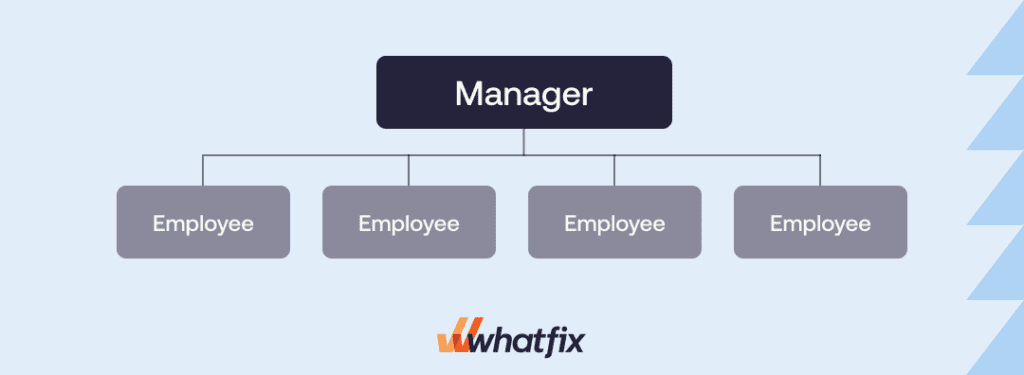
Due to its simple nature, a flat organization structure, also called a “flatarchy” or a horizontal structure, is typically used by small businesses and startups. Organizations often start with a flat structure and then transition to a different type of org structure late in their maturity.
In a flat organizational structure, there are few middle managers between employees and top managers. The structure requires less supervision, increases employee involvement, and boosts trust in the workplace.
Best for: Smaller companies and startups that require faster decision-making and a collaborative culture, accelerating innovation and flexibility.
Pros of a flat structure:
- More responsibility for employees.
- Open communication.
- Clear path of approval.
- Change and improvement implementation happen fast.
- Rewards adaptability, flexibility, and innovation.
Cons of a flat structure:
- Not scalable.
- Often leads to confusion, as employees lack a clear supervisor or manager.
- Relies on one person to be the decision-maker.
- Leads to employees with generalized skills with a lack of specializations.
- Difficult to maintain when organizations start to scale.
Is It Possible to Change an Organization’s Structure?
Of course, organizational design can be reconstructed if needed. The business landscape is constantly evolving, and keeping to a structure that has worked for years might simply become inefficient.
To adapt to market changes, you might need to resort to organizational transformation, which affects not only your strategy but also your structure. Whether you want to build an organizational structure from scratch or want to revisit the existing one, you’ll need to get down to the basics.
How to Design Your Organization’s Structure
Whatever structure you choose, you’ll need to make an effort to implement it. Here are eight simple steps towards designing an organizational structure from scratch.
1. Create a charter
First of all, you need to prepare documentation.
You need a project charter outlining the purpose of building a clear structure, key stakeholders, and their responsibilities. This is your rough plan for implementing an organizational structure that should give you a direction for your next steps.
When creating a charter, you’ll be able to answer the following questions:
- Why do we need to design (or re-design) an organizational structure?
- When do we start?
- Who are the key stakeholders in this project?
- What should we do first?
- Where is the company headed? Will our organizational structure be relevant in a year?
2. Consider factors that influence your organizational structure choice
To build a structure from scratch, you’ll need to start by outlining a long-term strategy and mapping out goals. Your future vision of your company determines which type of organizational structure will work best for you.
When ideating your company strategy and organizational structure, consider your company’s various contextual elements, traits, characteristics, and challenges. These will help you choose the appropriate organizational structure for your company. Consider the following factors:
- Company size: How many employees will your company have? What will be its operational reach? How complex will your teams be?
- Business goals and strategy: What are your business objectives? How will you succeed? What does that path look like? What traits will help your company thrive?
- Industry dynamics: What external factors will impact your company? Is your sector a digital laggard or an early tech adopter? How regulated is your industry? Look to other companies in your industry to see how they structure their org chart.
- Company values: What are your company’s core beliefs and values? What role will company culture play in your organization? Will you be more relaxed or need to be more authoritarian in your people management?
- Product or service complexity: How complex are your selling goods or services? Will you have multiple product lines? Depending on the customer profile, will they need to be packaged and marketed differently? How mature is your product and industry?
3. Assess your internal processes & systems
If your business has already been operating for quite some time, take a look at your current strategy and try to highlight the areas of improvement. Do you need to revisit your core ideology and company culture? You can only answer this question by talking to your employees and managers.
When you know where you stand and have a clear vision of what you want to achieve, creating an organizational direction shouldn’t be a problem.
4. Design your structure
A clear understanding of your company’s strategy lets you filter out irrelevant organizational structure types and pick the one that fits with your core values, mission, and goals.
Choose one of the seven organizational structures and use it as a template for designing a custom organizational chart. This chart is also known as an organogram – it’s a diagram used to visualize the relationships between individuals, teams, and departments within an organization
5. Create a transition plan
Next, it’s time to design an optimal workflow for implementing or switching to a new structure.
Talk to the stakeholders and decide on the deadlines for establishing a brand new organizational structure. Prepare a list of recommendations for top managers and team leaders that will help to communicate the change to the rest of the organization.
6. Implement your new structure
From there, leaders should create an implementation plan that includes training their teams to adopt new roles and skills, as well as how to follow a new decision-making and reporting framework. Week by week, employees will become accustomed to their new organizational structure and adapt to the change.
7. Monitor the impact
The transition process might take months, and it’s very likely that the performance of individual employees or even entire teams will go down at some point. However, you can assess the impact of a new structure only after the transition is complete.
With a new organizational structure in place, run the performance review and talk to executives. It’s important that you monitor the contribution of each individual department – chances are the changes don’t work equally well for everyone at the company.
8. Gather feedback & improve
Again, once you implement an organizational structure, it’s never too late to make adjustments. Alongside performance checks, survey your employees to learn how they feel about a new structure. It can be that their input will help you fine-tune the organizational design without extra cost and effort.
Ready to learn more about building healthy, innovative organizations? These resources can help:
- Types of Organizational Change
- Overcoming Resistance to Change
- Employee Training Methods
- Digital Transformation Challenges
Digital Transformation Clicks Better With Whatfix
As organizations mature, issues will arise that will pressure your company and require changes to your structure, like expanding to new markets, acquiring companies, consolidating functions, and introducing new products. While often necessary, this will cause downstream effects that will also need to be solved head on, like consolidating multiple applications into one system, modernizing legacy systems, streamlining processes, and introducing new technologies.
With Whatfix, organizations can drive user adoption as structures change with:
- Whatfix Mirror enables L&D teams to create sandbox application environments, allowing end-users to learn their tasks and processes via hands-on training in a risk-free sandbox environment.
- Whatfix DAP overlays your applications and supports end-users in the flow of work with Flows, Task Lists, Pop-Ups, Smart Tips, and Self Help. This allows employees to be guided in their contextual tasks to improve time-to-completion and process governance, driving business outcomes.
- Whatfix Product Analytics is a no-code user event tracking tool to track, analyze, and understand how employees use applications. With Product Analytics, build Funnels to see where users are encountering process friction, identify teams or functions that are incorrectly using software, and identify areas of workflow optimization.




